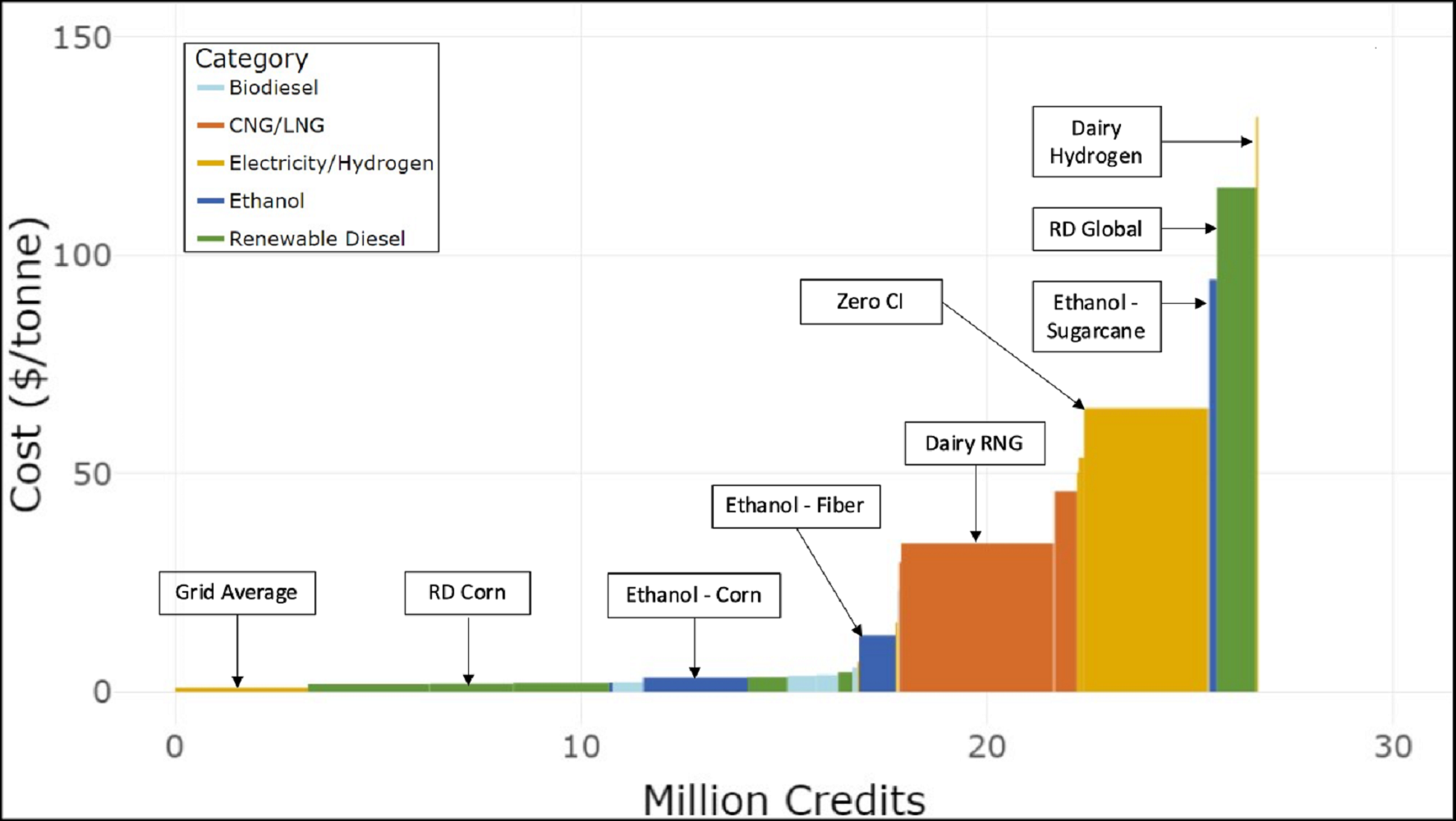Life Cycle Associates develops LCFS Credit Supply Curve for 2022

Life Cycle Associates developed a LCFS Credit Supply Curve depicting the 2022 alternative fuel portfolio in California under the Low Carbon Fuel Standard (LCFS). The LCFS Credit Supply Curve is based on the latest data from the California Air Resources Board (CARB) and reveals key insights into credit generation, surplus, and the impact on greenhouse gas emissions in the transportation sector.
LCFS credits and key fuel categories
CARB estimates that 26.85 million metric tons of LCFS credits were generated in 2022, with electricity, renewable diesel, and biomethane emerging as the primary contributors. We will delve deeper into these fuel categories later on.
The role of the LCFS in carbon intensity reduction
The transportation sector accounts for the largest share of greenhouse gas emissions in California, representing 38 percent of all emissions in 2020. Hence, the LCFS plays a vital role in reducing these emissions.
The program targets 20% reductions by 2030 and has already succeeded in cutting transportation sector emissions by over 12% since its implementation in 2011.
The 2022 estimated surplus is 5.62 million credits, driving significant growth in the LCFS credit bank to 15.1 million credits overall.
The LCFS is designed to decrease the carbon intensity (CI) of the transportation sector by incentivizing low-carbon and renewable fuel alternatives similar to proposed national and international policies. Life Cycle Associates, known for their expertise in modeling alternative fuel scenarios, employs supply curves to estimate the credit generation impact of diverse policy and technology scenarios.
Electricity/hydrogen reach record credit contribution
Electricity’s LCFS credit contribution reached a record in 2022, with nearly 6.5 million credits or approximately 24% of all credits generated. Zero Emission Vehicle (ZEV) registrations accounted for 18.8% of all new vehicles in 2022 according to the California Energy Commission, powered by the states’ growing number of 87,000 public charging stations.
However, electrification of the vehicle fleet likely requires a substantial increase in the use of renewable energy sources. To be specific, a large share of renewable energy certificates (RECs) derived from sources such as geothermal, wind, or solar will be needed to support the growing demand for electric vehicle charging.
Renewable diesel remains leading credit generator
In 2022, renewable diesel maintained its role as the LCFS’ largest credit generator, a distinction is has held since 2018.
Renewable diesel used in California contains a growing share of distiller’s corn oil, a co-product of U.S. ethanol production, along with used cooking oil (UCO), soy, and tallow. Biomass-based diesel tax credits were extended through 2024 by the Inflation Reduction Act (IRA) signed in August 2022.
Biomethane (CNG/LNG) as a growing alternative fuel category
A record number of dairy biomethane processors came online in California in 2021. The growth continued in 2022, boosting biomethane as the third alternative fuel category leading the 2022 credit surplus. LCFS credits from biomethane include renewable feedstocks such as landfill gas and dairy and swine manure.
Ethanol and biodiesel’s contributions
While ethanol remained the volume leader in LCFS compliance as it has since 2011, renewable diesel’s continued growth narrowed the margin considerably in 2022.
Ethanol and biodiesel continue to contribute to LCFS credit generation, comprising 14 percent and 8 percent of total credits in 2022, respectively. The ethanol industry will need to leverage carbon capture storage (CCS) to meet increasingly stringent CI requirements.
Life Cycle Associates: Reducing Emissions and Environmental Impact
Life Cycle Associates is a trusted partner for clients worldwide, assisting in emissions reduction and environmental impact mitigation. Our expertise lies in life cycle greenhouse gas emission analysis of fuel and energy production pathways, with extensive use of models such as GREET, GTAP, and LEM.
We offer services that include the modification of the California GREET model, development of initial pathway documents for the LCFS, support for fuel pathways under the LCFS, RFS2, and EU Renewable Energy Directive (RED), as well as determining the applicability of Inflation Reduction Act (IRA) provisions.
Contact us today for questions about the LCFS Credit Supply Curve or to learn more about how we can assist you. We would love to hear from you.
